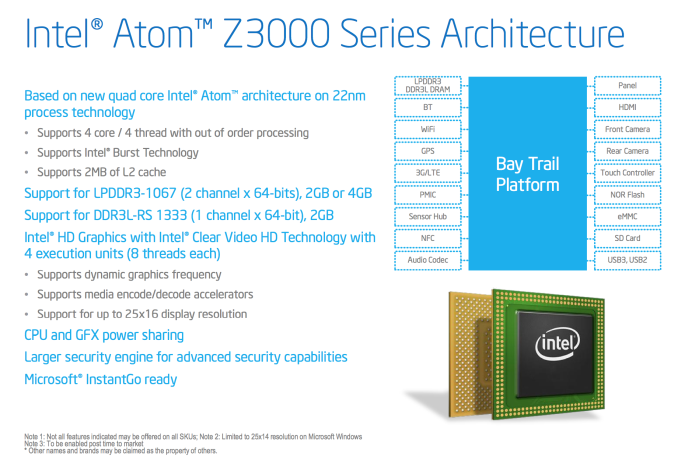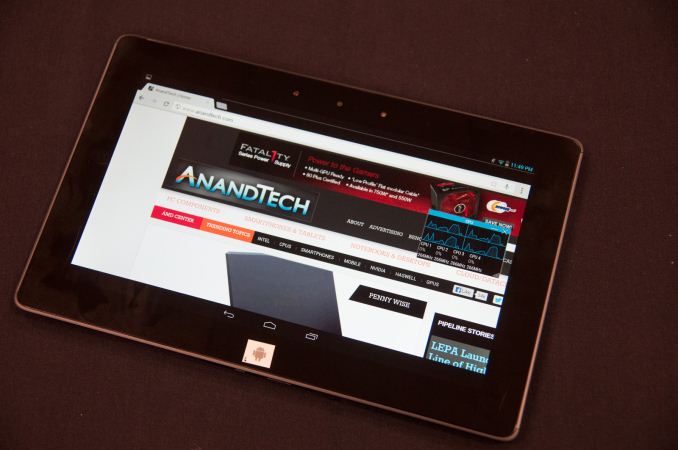The Bay Trail Preview: Intel Atom Z3770 Tested
by Anand Lal Shimpi & Brian Klug on September 11, 2013 12:00 PM ESTFinal Words
At its Silvermont disclosure, Intel promised performance better than any other ARM based core in the market today. Looking at our Android results, Intel appears to have delivered on that claim. Whether we’re talking about Cortex A15 in NVIDIA’s Shield or Qualcomm’s Krait 400, Silvermont is quicker. It seems safe to say that Intel will have the fastest CPU performance out of any Android tablet platform once Bay Trail ships later this year.
The power consumption, at least on the CPU side, also looks very good. From our SoC measurements it looks like Bay Trail’s power consumption under heavy CPU load ranges from 1W - 2.5W, putting it on par with other mobile SoCs that we’ve done power measurements on.
On the GPU side, Intel’s HD Graphics does reasonably well in its first showing in an ultra mobile SoC. Bay Trail appears to live in a weird world between the old Intel that didn’t care about graphics and the new Intel that has effectively become a GPU company. Intel’s HD graphics in Bay Trail appear to be similar in performance to the PowerVR SGX 554MP4 in the iPad 4. It’s a huge step forward compared to Clover Trail, but clearly not a leadership play, which is disappointing.
The big unknowns are things like video decode power efficiency, perf and quality of their ISP and idle power efficiency vs. Qualcomm.
Bay Trail looks like a good starting point for Intel in mobile, and the performance of Silvermont makes me excited for Merrifield in phones next year. What Intel needs to do going forward is simply continue to iterate and execute for the next few generations after Bay Trail and it will have a real chance at success in mobile.
My biggest concern is about the design wins we see based around Bay Trail. Although Intel is finally in a spot where it can be in devices on the market, none of those devices thus far have been any good. Bay Trail is attractive enough to garner more design wins for certain, the question is whether or not the quality of those wins will improve as well. In the tablet market there’s the iPad and the Nexus lines that are really the most interesting, and I don’t expect Bay Trail to be in either. Whether or not the quality of the rest goes up this generation and we find a Bay Trail in one of those devices remains to be seen.












190 Comments
View All Comments
Speedfriend - Thursday, September 12, 2013 - link
"And on GPU, it concluded with " Intel's HD graphics in Bay Trail appear to be similar in performance to the PowerVR SGX 554MP4 in the iPad 4" I mean unless you are interpreting the results much more differently then what i read i the graph. Then please do explain yourself there. Because I dont read how it is "similar". There are like at least 20% of performance difference."In T-Rex offscreen, it equals the iPad4, so I would say he is correct, but off course T4 and Adreno 330 are significantly ahead. Intel have probably realised that most consumers don't know or care what graphics are in their tablet/phone and are sold on core and Mhz.
What people don't seem to realise is how strong the Intel inside argument will be in tablet sales, given they will mostly be bought in computer store alongside laptops. No consumer has any idea who ARM or Qualcomm are.
monstercameron - Friday, September 13, 2013 - link
I dont but the mhz/core argument, besides apple has shown -for 3 generations now- that cpu performance doesnt matter, the gpu is where it is at. Just look at the tegra 3 and apple a6x.JPForums - Thursday, September 12, 2013 - link
Or, ya know, he only had a couple of hours with the platform including install time. You might get a more in depth look once devices hit the labs.
He only had a couple of hours to test. I'm pretty sure new iPad wasn't launch in this time frame. When the new iPad is launched, I suspect, based on past experience, that Anand and his associates will test it and compare it to the other products available to them at that time. Throwing a little tid bit of what is to come based on information you already possess is fine and dandy, but you don't want to mix speculation with your actual performance comparisons.
The only way to compare this to the up coming A7X in a relevant manner is to wait until it comes out. However, there will always be a newer potentially better product coming out "soon". Then he really would have to show a bias in choosing which new product to launch the article around. Furthermore, he would deprive his readers of the information he has now.
The data is presented in an easy to read fashion so that you can come to your own conclusions, even if they conflict with his. This shows that he assumes that (at least some of) his reader are capable of analyzing data and making informed conclusion based on it. For instance, there has been mention of the soon to be released A7X chip and based on the details given, we can make an informed hypothesis on where its performance will be. However, lack of other details leave other aspects of its performance unknown. Rather than speculated about an unknown as if you weren't intelligent enough to come to your own conclusions, Anand has presented you with data that you can draw conclusions from and speculate on your own about its performance relative to the A7X. When it is released, I'm sure you will see an article with hard facts.
ancientarcher - Friday, September 13, 2013 - link
blah blah blah blah...c;mon enough of Intel defence. Do it better next time, and in fewer words.
He was just trying to compare Baytrail with devices that it will actually compete with like A7X.
on the CPU point, why does Anand always use Javascript?
Maybe you should compare Intel on AnTuTu also and then say how it is 150000% better
iwod - Saturday, September 14, 2013 - link
After some much deeper thoughts and research. I think the conclusion is still a little too good. But it is at least good enough for Intel to compete with the best. The problem is Anand didn't highlight enough why. And merely saying this is good isn't much of a technical reviews while those numbers speak things very differently.fteoath64 - Thursday, September 12, 2013 - link
Actually, the base frequency of these Bay Trial Atoms set at 1.3Ghz is a telling sign. A sign that even with 22nm process, BT cannot seem to power well at 1.6Ghz or as some might expect 2.0Ghz. To see that it uses "turbo core" tricks to overclock is some form of cheating but non the less useful to achieve the target performance at the expense of power. Sure, all Arm cores power down to close to 200Mhz when idle but their "base frequency" was around 1.6 Ghz rather than 1.3Ghz. So the microarchitecture does not scale well to power use in the perf/watt metric. Nice attempt but so-so outcome. And do not tell us going to 14nm is going to solve all of these. When the Arm chips get to 20nm, it is game over in this segment for non-Arm.JPForums - Thursday, September 12, 2013 - link
It seems to me that the multi threaded integer performance in the 7-Zip benchmark is similarly higher (25% and 27% respectively).
What are the chances that the difference in memory subsystem is partially responsible? When you have more time with Bay Trail on hand, I'd sure like to see the cache and memory latencies and bandwidths.
klagermkii - Thursday, September 12, 2013 - link
My biggest take away from this is seeing an Atom beating the Jaguar cores that are appearing in the next console gen and that worries me for the longevity of the next console cycle. Are we a year away from seeing mainstream smartphones that have faster single threaded performance than the premier consoles?JumpingJack - Thursday, September 12, 2013 - link
CPU performance is stellar, GPU is basically average -- consoles need the GPU ummmphhhhh, I don't see this impacting consoles at all. In addition, the margins on consoles are so low I suspect Intel (if they had a compelling solution) would walk away from the business anyway, much like nVidia did.Gunbuster - Thursday, September 12, 2013 - link
I just don't understand why they are sticking with the Atom branding. I think they would be much better off starting with a new name and 0 consumer perception rather than Atom and negative 9000.